Attracting & Retaining Workforce: HRM Challenges in Financial Sector
VerifiedAdded on 2023/04/25
|14
|4106
|340
Essay
AI Summary
This essay delves into the significant challenges faced by financial companies in attracting and retaining talented employees. It draws upon various discussions, including recruitment and selection, employee relations, performance management, motivation, rewards, compensation, and employee turnover. The challenges identified encompass difficulties in attracting talented candidates due to a candidate-driven market, delays in the hiring process, a lack of alignment between hiring managers and recruiters, and the need to retain millennial employees. Employee relations challenges include legal issues, conflict management, attendance problems, and disciplinary actions. Performance management is hindered by a lack of alignment, inadequate measurements, insufficient leadership commitment, and difficulties in managing poor performance. Furthermore, the essay addresses how inadequate resources and a lack of employee rewards and pay can negatively impact employee motivation and retention. Desklib provides a platform for students to access this and many other solved assignments.

Running head: HRM
HRM
HRM
Paraphrase This Document
Need a fresh take? Get an instant paraphrase of this document with our AI Paraphraser
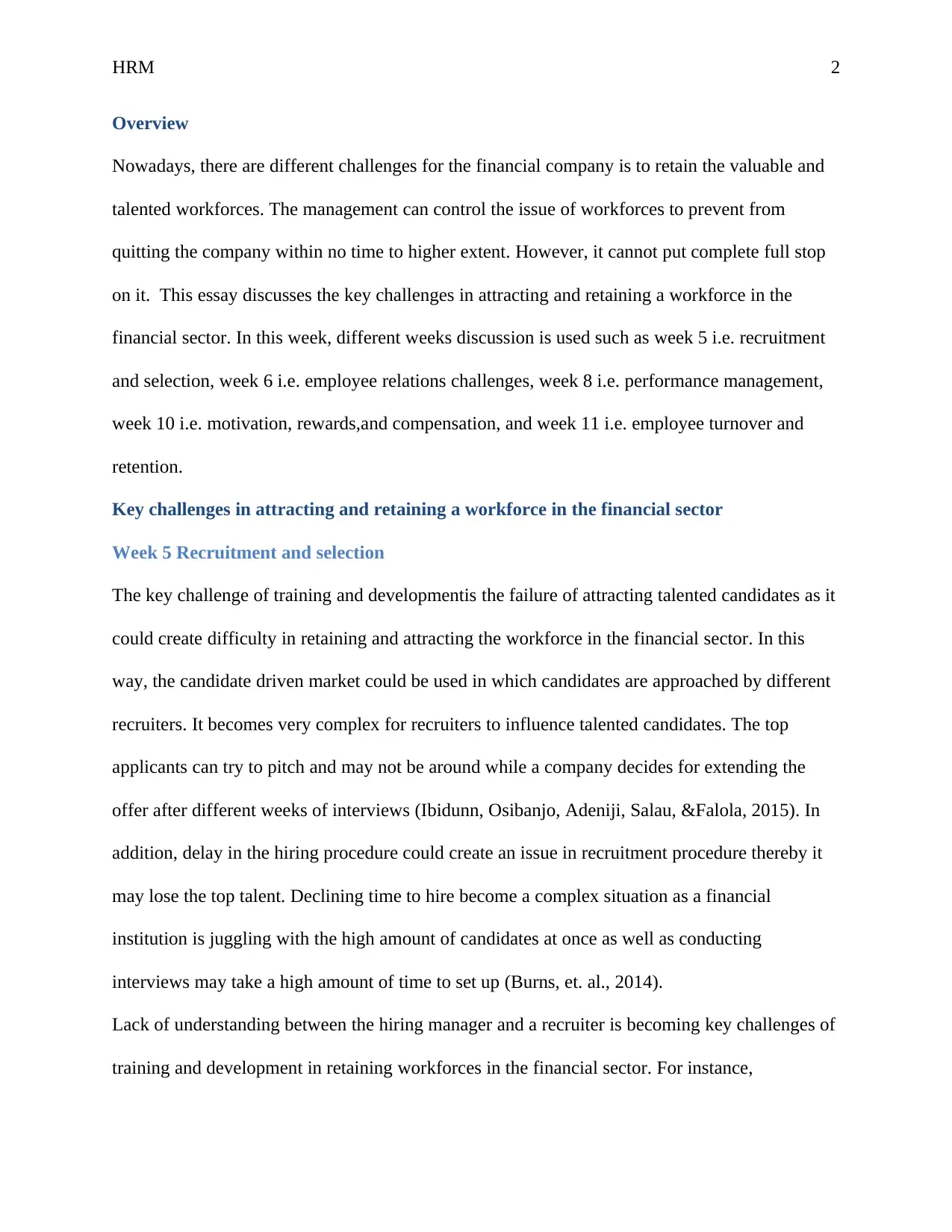
HRM 2
Overview
Nowadays, there are different challenges for the financial company is to retain the valuable and
talented workforces. The management can control the issue of workforces to prevent from
quitting the company within no time to higher extent. However, it cannot put complete full stop
on it. This essay discusses the key challenges in attracting and retaining a workforce in the
financial sector. In this week, different weeks discussion is used such as week 5 i.e. recruitment
and selection, week 6 i.e. employee relations challenges, week 8 i.e. performance management,
week 10 i.e. motivation, rewards,and compensation, and week 11 i.e. employee turnover and
retention.
Key challenges in attracting and retaining a workforce in the financial sector
Week 5 Recruitment and selection
The key challenge of training and developmentis the failure of attracting talented candidates as it
could create difficulty in retaining and attracting the workforce in the financial sector. In this
way, the candidate driven market could be used in which candidates are approached by different
recruiters. It becomes very complex for recruiters to influence talented candidates. The top
applicants can try to pitch and may not be around while a company decides for extending the
offer after different weeks of interviews (Ibidunn, Osibanjo, Adeniji, Salau, &Falola, 2015). In
addition, delay in the hiring procedure could create an issue in recruitment procedure thereby it
may lose the top talent. Declining time to hire become a complex situation as a financial
institution is juggling with the high amount of candidates at once as well as conducting
interviews may take a high amount of time to set up (Burns, et. al., 2014).
Lack of understanding between the hiring manager and a recruiter is becoming key challenges of
training and development in retaining workforces in the financial sector. For instance,
Overview
Nowadays, there are different challenges for the financial company is to retain the valuable and
talented workforces. The management can control the issue of workforces to prevent from
quitting the company within no time to higher extent. However, it cannot put complete full stop
on it. This essay discusses the key challenges in attracting and retaining a workforce in the
financial sector. In this week, different weeks discussion is used such as week 5 i.e. recruitment
and selection, week 6 i.e. employee relations challenges, week 8 i.e. performance management,
week 10 i.e. motivation, rewards,and compensation, and week 11 i.e. employee turnover and
retention.
Key challenges in attracting and retaining a workforce in the financial sector
Week 5 Recruitment and selection
The key challenge of training and developmentis the failure of attracting talented candidates as it
could create difficulty in retaining and attracting the workforce in the financial sector. In this
way, the candidate driven market could be used in which candidates are approached by different
recruiters. It becomes very complex for recruiters to influence talented candidates. The top
applicants can try to pitch and may not be around while a company decides for extending the
offer after different weeks of interviews (Ibidunn, Osibanjo, Adeniji, Salau, &Falola, 2015). In
addition, delay in the hiring procedure could create an issue in recruitment procedure thereby it
may lose the top talent. Declining time to hire become a complex situation as a financial
institution is juggling with the high amount of candidates at once as well as conducting
interviews may take a high amount of time to set up (Burns, et. al., 2014).
Lack of understanding between the hiring manager and a recruiter is becoming key challenges of
training and development in retaining workforces in the financial sector. For instance,
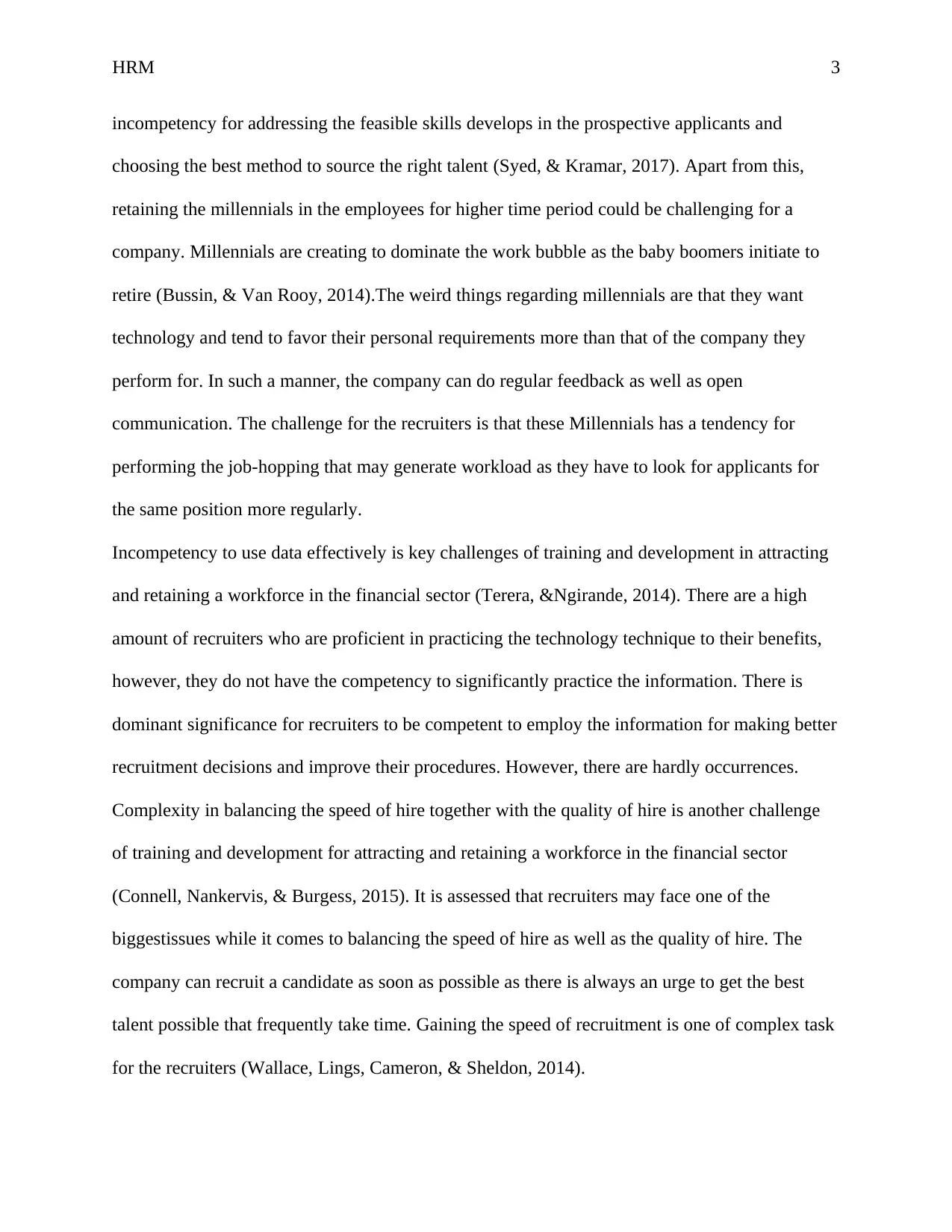
HRM 3
incompetency for addressing the feasible skills develops in the prospective applicants and
choosing the best method to source the right talent (Syed, & Kramar, 2017). Apart from this,
retaining the millennials in the employees for higher time period could be challenging for a
company. Millennials are creating to dominate the work bubble as the baby boomers initiate to
retire (Bussin, & Van Rooy, 2014).The weird things regarding millennials are that they want
technology and tend to favor their personal requirements more than that of the company they
perform for. In such a manner, the company can do regular feedback as well as open
communication. The challenge for the recruiters is that these Millennials has a tendency for
performing the job-hopping that may generate workload as they have to look for applicants for
the same position more regularly.
Incompetency to use data effectively is key challenges of training and development in attracting
and retaining a workforce in the financial sector (Terera, &Ngirande, 2014). There are a high
amount of recruiters who are proficient in practicing the technology technique to their benefits,
however, they do not have the competency to significantly practice the information. There is
dominant significance for recruiters to be competent to employ the information for making better
recruitment decisions and improve their procedures. However, there are hardly occurrences.
Complexity in balancing the speed of hire together with the quality of hire is another challenge
of training and development for attracting and retaining a workforce in the financial sector
(Connell, Nankervis, & Burgess, 2015). It is assessed that recruiters may face one of the
biggestissues while it comes to balancing the speed of hire as well as the quality of hire. The
company can recruit a candidate as soon as possible as there is always an urge to get the best
talent possible that frequently take time. Gaining the speed of recruitment is one of complex task
for the recruiters (Wallace, Lings, Cameron, & Sheldon, 2014).
incompetency for addressing the feasible skills develops in the prospective applicants and
choosing the best method to source the right talent (Syed, & Kramar, 2017). Apart from this,
retaining the millennials in the employees for higher time period could be challenging for a
company. Millennials are creating to dominate the work bubble as the baby boomers initiate to
retire (Bussin, & Van Rooy, 2014).The weird things regarding millennials are that they want
technology and tend to favor their personal requirements more than that of the company they
perform for. In such a manner, the company can do regular feedback as well as open
communication. The challenge for the recruiters is that these Millennials has a tendency for
performing the job-hopping that may generate workload as they have to look for applicants for
the same position more regularly.
Incompetency to use data effectively is key challenges of training and development in attracting
and retaining a workforce in the financial sector (Terera, &Ngirande, 2014). There are a high
amount of recruiters who are proficient in practicing the technology technique to their benefits,
however, they do not have the competency to significantly practice the information. There is
dominant significance for recruiters to be competent to employ the information for making better
recruitment decisions and improve their procedures. However, there are hardly occurrences.
Complexity in balancing the speed of hire together with the quality of hire is another challenge
of training and development for attracting and retaining a workforce in the financial sector
(Connell, Nankervis, & Burgess, 2015). It is assessed that recruiters may face one of the
biggestissues while it comes to balancing the speed of hire as well as the quality of hire. The
company can recruit a candidate as soon as possible as there is always an urge to get the best
talent possible that frequently take time. Gaining the speed of recruitment is one of complex task
for the recruiters (Wallace, Lings, Cameron, & Sheldon, 2014).
⊘ This is a preview!⊘
Do you want full access?
Subscribe today to unlock all pages.

Trusted by 1+ million students worldwide
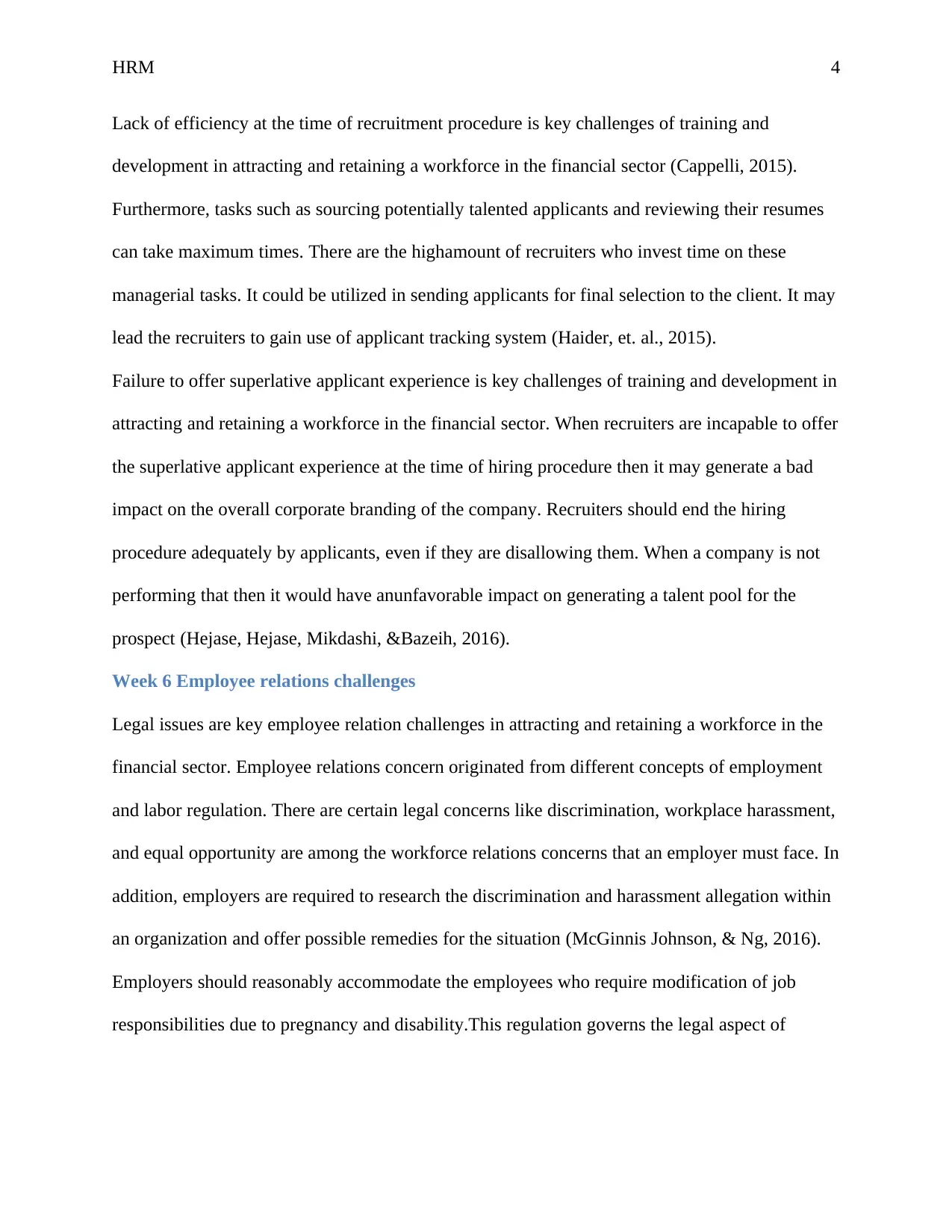
HRM 4
Lack of efficiency at the time of recruitment procedure is key challenges of training and
development in attracting and retaining a workforce in the financial sector (Cappelli, 2015).
Furthermore, tasks such as sourcing potentially talented applicants and reviewing their resumes
can take maximum times. There are the highamount of recruiters who invest time on these
managerial tasks. It could be utilized in sending applicants for final selection to the client. It may
lead the recruiters to gain use of applicant tracking system (Haider, et. al., 2015).
Failure to offer superlative applicant experience is key challenges of training and development in
attracting and retaining a workforce in the financial sector. When recruiters are incapable to offer
the superlative applicant experience at the time of hiring procedure then it may generate a bad
impact on the overall corporate branding of the company. Recruiters should end the hiring
procedure adequately by applicants, even if they are disallowing them. When a company is not
performing that then it would have anunfavorable impact on generating a talent pool for the
prospect (Hejase, Hejase, Mikdashi, &Bazeih, 2016).
Week 6 Employee relations challenges
Legal issues are key employee relation challenges in attracting and retaining a workforce in the
financial sector. Employee relations concern originated from different concepts of employment
and labor regulation. There are certain legal concerns like discrimination, workplace harassment,
and equal opportunity are among the workforce relations concerns that an employer must face. In
addition, employers are required to research the discrimination and harassment allegation within
an organization and offer possible remedies for the situation (McGinnis Johnson, & Ng, 2016).
Employers should reasonably accommodate the employees who require modification of job
responsibilities due to pregnancy and disability.This regulation governs the legal aspect of
Lack of efficiency at the time of recruitment procedure is key challenges of training and
development in attracting and retaining a workforce in the financial sector (Cappelli, 2015).
Furthermore, tasks such as sourcing potentially talented applicants and reviewing their resumes
can take maximum times. There are the highamount of recruiters who invest time on these
managerial tasks. It could be utilized in sending applicants for final selection to the client. It may
lead the recruiters to gain use of applicant tracking system (Haider, et. al., 2015).
Failure to offer superlative applicant experience is key challenges of training and development in
attracting and retaining a workforce in the financial sector. When recruiters are incapable to offer
the superlative applicant experience at the time of hiring procedure then it may generate a bad
impact on the overall corporate branding of the company. Recruiters should end the hiring
procedure adequately by applicants, even if they are disallowing them. When a company is not
performing that then it would have anunfavorable impact on generating a talent pool for the
prospect (Hejase, Hejase, Mikdashi, &Bazeih, 2016).
Week 6 Employee relations challenges
Legal issues are key employee relation challenges in attracting and retaining a workforce in the
financial sector. Employee relations concern originated from different concepts of employment
and labor regulation. There are certain legal concerns like discrimination, workplace harassment,
and equal opportunity are among the workforce relations concerns that an employer must face. In
addition, employers are required to research the discrimination and harassment allegation within
an organization and offer possible remedies for the situation (McGinnis Johnson, & Ng, 2016).
Employers should reasonably accommodate the employees who require modification of job
responsibilities due to pregnancy and disability.This regulation governs the legal aspect of
Paraphrase This Document
Need a fresh take? Get an instant paraphrase of this document with our AI Paraphraser
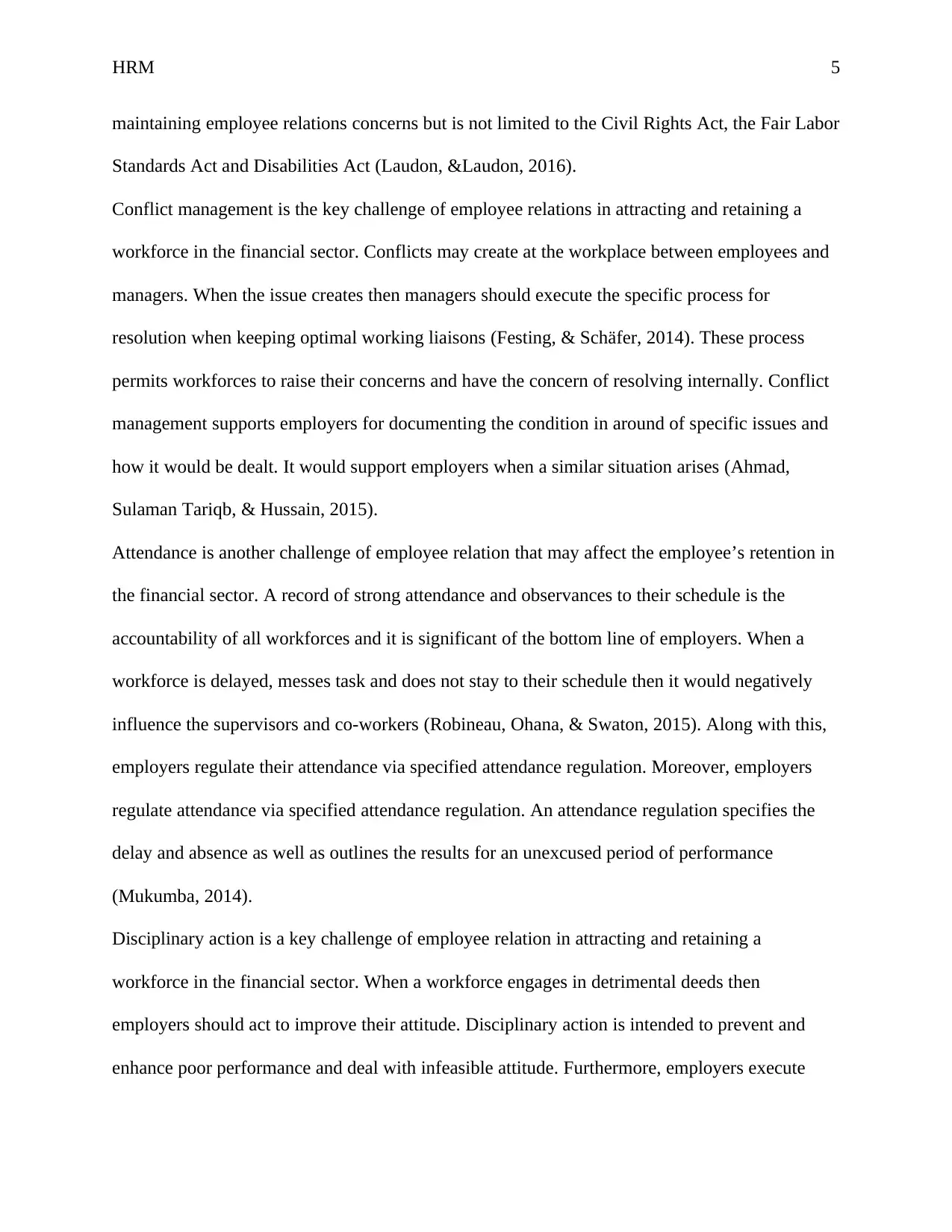
HRM 5
maintaining employee relations concerns but is not limited to the Civil Rights Act, the Fair Labor
Standards Act and Disabilities Act (Laudon, &Laudon, 2016).
Conflict management is the key challenge of employee relations in attracting and retaining a
workforce in the financial sector. Conflicts may create at the workplace between employees and
managers. When the issue creates then managers should execute the specific process for
resolution when keeping optimal working liaisons (Festing, & Schäfer, 2014). These process
permits workforces to raise their concerns and have the concern of resolving internally. Conflict
management supports employers for documenting the condition in around of specific issues and
how it would be dealt. It would support employers when a similar situation arises (Ahmad,
Sulaman Tariqb, & Hussain, 2015).
Attendance is another challenge of employee relation that may affect the employee’s retention in
the financial sector. A record of strong attendance and observances to their schedule is the
accountability of all workforces and it is significant of the bottom line of employers. When a
workforce is delayed, messes task and does not stay to their schedule then it would negatively
influence the supervisors and co-workers (Robineau, Ohana, & Swaton, 2015). Along with this,
employers regulate their attendance via specified attendance regulation. Moreover, employers
regulate attendance via specified attendance regulation. An attendance regulation specifies the
delay and absence as well as outlines the results for an unexcused period of performance
(Mukumba, 2014).
Disciplinary action is a key challenge of employee relation in attracting and retaining a
workforce in the financial sector. When a workforce engages in detrimental deeds then
employers should act to improve their attitude. Disciplinary action is intended to prevent and
enhance poor performance and deal with infeasible attitude. Furthermore, employers execute
maintaining employee relations concerns but is not limited to the Civil Rights Act, the Fair Labor
Standards Act and Disabilities Act (Laudon, &Laudon, 2016).
Conflict management is the key challenge of employee relations in attracting and retaining a
workforce in the financial sector. Conflicts may create at the workplace between employees and
managers. When the issue creates then managers should execute the specific process for
resolution when keeping optimal working liaisons (Festing, & Schäfer, 2014). These process
permits workforces to raise their concerns and have the concern of resolving internally. Conflict
management supports employers for documenting the condition in around of specific issues and
how it would be dealt. It would support employers when a similar situation arises (Ahmad,
Sulaman Tariqb, & Hussain, 2015).
Attendance is another challenge of employee relation that may affect the employee’s retention in
the financial sector. A record of strong attendance and observances to their schedule is the
accountability of all workforces and it is significant of the bottom line of employers. When a
workforce is delayed, messes task and does not stay to their schedule then it would negatively
influence the supervisors and co-workers (Robineau, Ohana, & Swaton, 2015). Along with this,
employers regulate their attendance via specified attendance regulation. Moreover, employers
regulate attendance via specified attendance regulation. An attendance regulation specifies the
delay and absence as well as outlines the results for an unexcused period of performance
(Mukumba, 2014).
Disciplinary action is a key challenge of employee relation in attracting and retaining a
workforce in the financial sector. When a workforce engages in detrimental deeds then
employers should act to improve their attitude. Disciplinary action is intended to prevent and
enhance poor performance and deal with infeasible attitude. Furthermore, employers execute
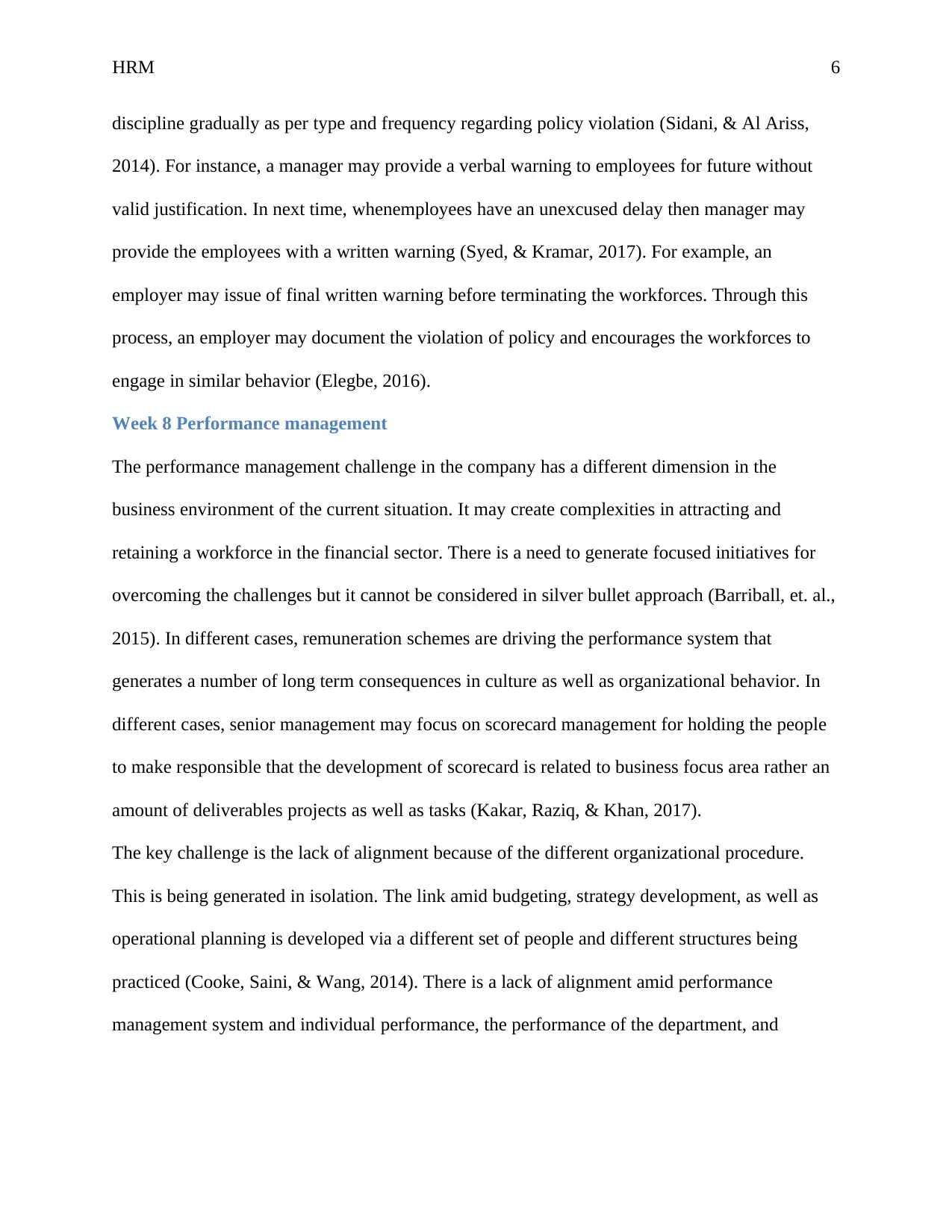
HRM 6
discipline gradually as per type and frequency regarding policy violation (Sidani, & Al Ariss,
2014). For instance, a manager may provide a verbal warning to employees for future without
valid justification. In next time, whenemployees have an unexcused delay then manager may
provide the employees with a written warning (Syed, & Kramar, 2017). For example, an
employer may issue of final written warning before terminating the workforces. Through this
process, an employer may document the violation of policy and encourages the workforces to
engage in similar behavior (Elegbe, 2016).
Week 8 Performance management
The performance management challenge in the company has a different dimension in the
business environment of the current situation. It may create complexities in attracting and
retaining a workforce in the financial sector. There is a need to generate focused initiatives for
overcoming the challenges but it cannot be considered in silver bullet approach (Barriball, et. al.,
2015). In different cases, remuneration schemes are driving the performance system that
generates a number of long term consequences in culture as well as organizational behavior. In
different cases, senior management may focus on scorecard management for holding the people
to make responsible that the development of scorecard is related to business focus area rather an
amount of deliverables projects as well as tasks (Kakar, Raziq, & Khan, 2017).
The key challenge is the lack of alignment because of the different organizational procedure.
This is being generated in isolation. The link amid budgeting, strategy development, as well as
operational planning is developed via a different set of people and different structures being
practiced (Cooke, Saini, & Wang, 2014). There is a lack of alignment amid performance
management system and individual performance, the performance of the department, and
discipline gradually as per type and frequency regarding policy violation (Sidani, & Al Ariss,
2014). For instance, a manager may provide a verbal warning to employees for future without
valid justification. In next time, whenemployees have an unexcused delay then manager may
provide the employees with a written warning (Syed, & Kramar, 2017). For example, an
employer may issue of final written warning before terminating the workforces. Through this
process, an employer may document the violation of policy and encourages the workforces to
engage in similar behavior (Elegbe, 2016).
Week 8 Performance management
The performance management challenge in the company has a different dimension in the
business environment of the current situation. It may create complexities in attracting and
retaining a workforce in the financial sector. There is a need to generate focused initiatives for
overcoming the challenges but it cannot be considered in silver bullet approach (Barriball, et. al.,
2015). In different cases, remuneration schemes are driving the performance system that
generates a number of long term consequences in culture as well as organizational behavior. In
different cases, senior management may focus on scorecard management for holding the people
to make responsible that the development of scorecard is related to business focus area rather an
amount of deliverables projects as well as tasks (Kakar, Raziq, & Khan, 2017).
The key challenge is the lack of alignment because of the different organizational procedure.
This is being generated in isolation. The link amid budgeting, strategy development, as well as
operational planning is developed via a different set of people and different structures being
practiced (Cooke, Saini, & Wang, 2014). There is a lack of alignment amid performance
management system and individual performance, the performance of the department, and
⊘ This is a preview!⊘
Do you want full access?
Subscribe today to unlock all pages.

Trusted by 1+ million students worldwide
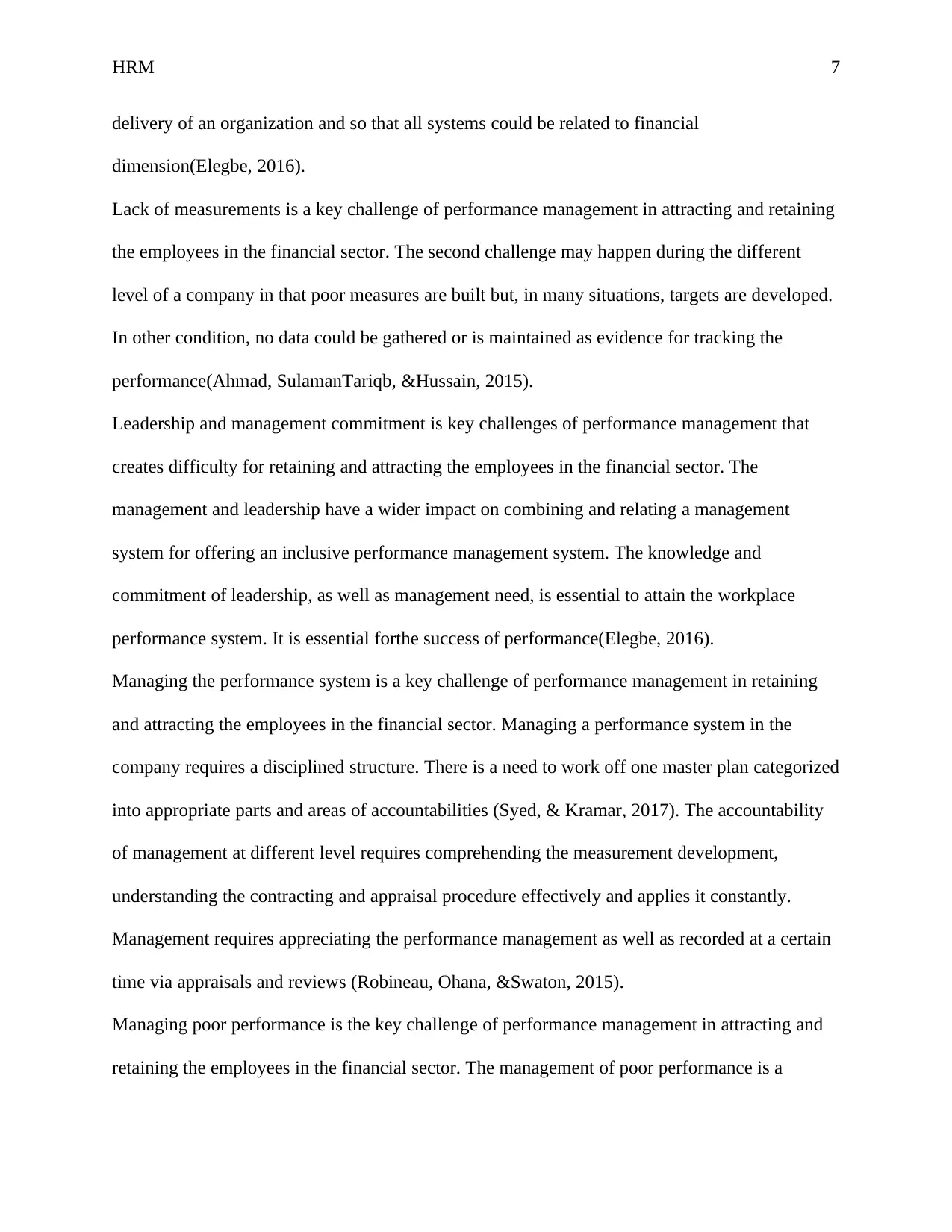
HRM 7
delivery of an organization and so that all systems could be related to financial
dimension(Elegbe, 2016).
Lack of measurements is a key challenge of performance management in attracting and retaining
the employees in the financial sector. The second challenge may happen during the different
level of a company in that poor measures are built but, in many situations, targets are developed.
In other condition, no data could be gathered or is maintained as evidence for tracking the
performance(Ahmad, SulamanTariqb, &Hussain, 2015).
Leadership and management commitment is key challenges of performance management that
creates difficulty for retaining and attracting the employees in the financial sector. The
management and leadership have a wider impact on combining and relating a management
system for offering an inclusive performance management system. The knowledge and
commitment of leadership, as well as management need, is essential to attain the workplace
performance system. It is essential forthe success of performance(Elegbe, 2016).
Managing the performance system is a key challenge of performance management in retaining
and attracting the employees in the financial sector. Managing a performance system in the
company requires a disciplined structure. There is a need to work off one master plan categorized
into appropriate parts and areas of accountabilities (Syed, & Kramar, 2017). The accountability
of management at different level requires comprehending the measurement development,
understanding the contracting and appraisal procedure effectively and applies it constantly.
Management requires appreciating the performance management as well as recorded at a certain
time via appraisals and reviews (Robineau, Ohana, &Swaton, 2015).
Managing poor performance is the key challenge of performance management in attracting and
retaining the employees in the financial sector. The management of poor performance is a
delivery of an organization and so that all systems could be related to financial
dimension(Elegbe, 2016).
Lack of measurements is a key challenge of performance management in attracting and retaining
the employees in the financial sector. The second challenge may happen during the different
level of a company in that poor measures are built but, in many situations, targets are developed.
In other condition, no data could be gathered or is maintained as evidence for tracking the
performance(Ahmad, SulamanTariqb, &Hussain, 2015).
Leadership and management commitment is key challenges of performance management that
creates difficulty for retaining and attracting the employees in the financial sector. The
management and leadership have a wider impact on combining and relating a management
system for offering an inclusive performance management system. The knowledge and
commitment of leadership, as well as management need, is essential to attain the workplace
performance system. It is essential forthe success of performance(Elegbe, 2016).
Managing the performance system is a key challenge of performance management in retaining
and attracting the employees in the financial sector. Managing a performance system in the
company requires a disciplined structure. There is a need to work off one master plan categorized
into appropriate parts and areas of accountabilities (Syed, & Kramar, 2017). The accountability
of management at different level requires comprehending the measurement development,
understanding the contracting and appraisal procedure effectively and applies it constantly.
Management requires appreciating the performance management as well as recorded at a certain
time via appraisals and reviews (Robineau, Ohana, &Swaton, 2015).
Managing poor performance is the key challenge of performance management in attracting and
retaining the employees in the financial sector. The management of poor performance is a
Paraphrase This Document
Need a fresh take? Get an instant paraphrase of this document with our AI Paraphraser
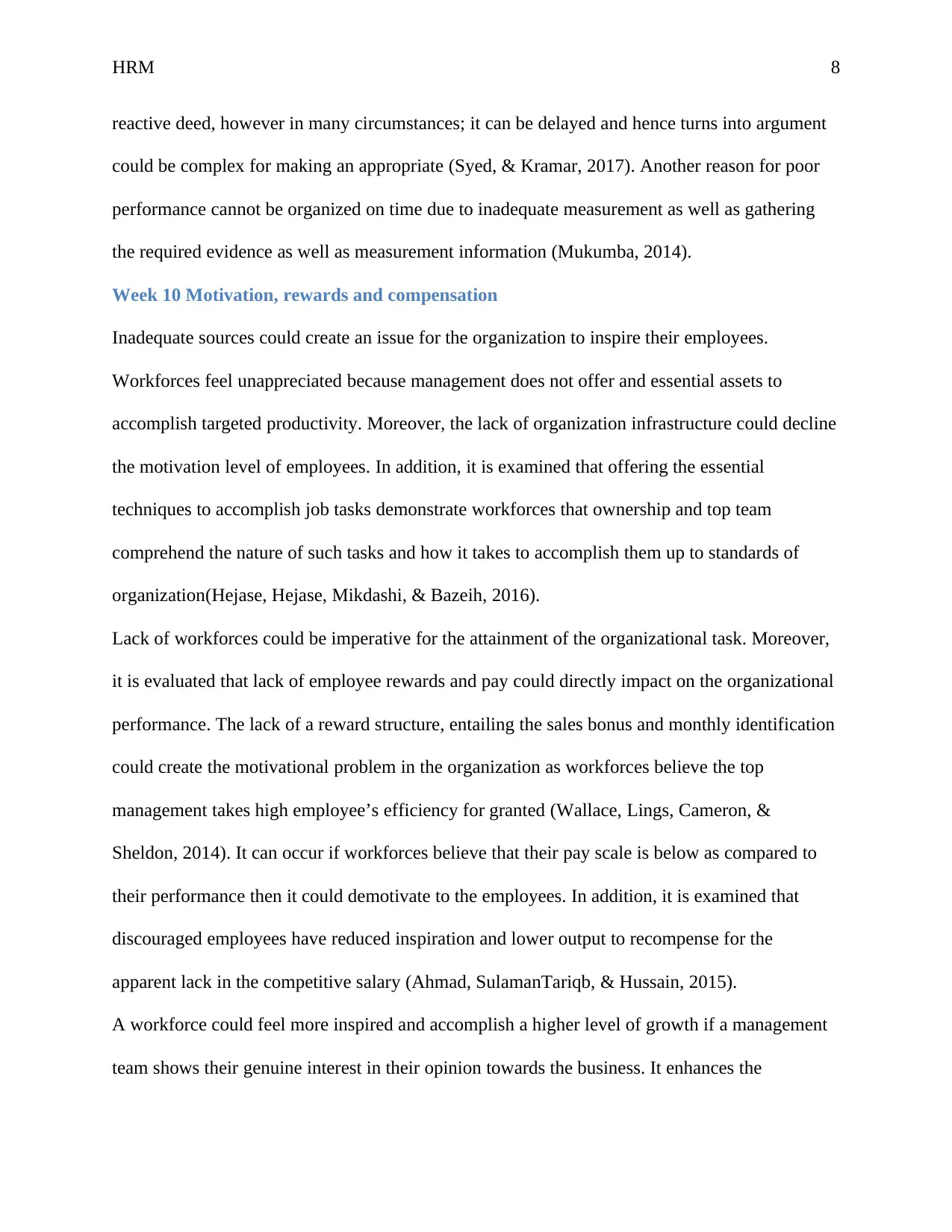
HRM 8
reactive deed, however in many circumstances; it can be delayed and hence turns into argument
could be complex for making an appropriate (Syed, & Kramar, 2017). Another reason for poor
performance cannot be organized on time due to inadequate measurement as well as gathering
the required evidence as well as measurement information (Mukumba, 2014).
Week 10 Motivation, rewards and compensation
Inadequate sources could create an issue for the organization to inspire their employees.
Workforces feel unappreciated because management does not offer and essential assets to
accomplish targeted productivity. Moreover, the lack of organization infrastructure could decline
the motivation level of employees. In addition, it is examined that offering the essential
techniques to accomplish job tasks demonstrate workforces that ownership and top team
comprehend the nature of such tasks and how it takes to accomplish them up to standards of
organization(Hejase, Hejase, Mikdashi, & Bazeih, 2016).
Lack of workforces could be imperative for the attainment of the organizational task. Moreover,
it is evaluated that lack of employee rewards and pay could directly impact on the organizational
performance. The lack of a reward structure, entailing the sales bonus and monthly identification
could create the motivational problem in the organization as workforces believe the top
management takes high employee’s efficiency for granted (Wallace, Lings, Cameron, &
Sheldon, 2014). It can occur if workforces believe that their pay scale is below as compared to
their performance then it could demotivate to the employees. In addition, it is examined that
discouraged employees have reduced inspiration and lower output to recompense for the
apparent lack in the competitive salary (Ahmad, SulamanTariqb, & Hussain, 2015).
A workforce could feel more inspired and accomplish a higher level of growth if a management
team shows their genuine interest in their opinion towards the business. It enhances the
reactive deed, however in many circumstances; it can be delayed and hence turns into argument
could be complex for making an appropriate (Syed, & Kramar, 2017). Another reason for poor
performance cannot be organized on time due to inadequate measurement as well as gathering
the required evidence as well as measurement information (Mukumba, 2014).
Week 10 Motivation, rewards and compensation
Inadequate sources could create an issue for the organization to inspire their employees.
Workforces feel unappreciated because management does not offer and essential assets to
accomplish targeted productivity. Moreover, the lack of organization infrastructure could decline
the motivation level of employees. In addition, it is examined that offering the essential
techniques to accomplish job tasks demonstrate workforces that ownership and top team
comprehend the nature of such tasks and how it takes to accomplish them up to standards of
organization(Hejase, Hejase, Mikdashi, & Bazeih, 2016).
Lack of workforces could be imperative for the attainment of the organizational task. Moreover,
it is evaluated that lack of employee rewards and pay could directly impact on the organizational
performance. The lack of a reward structure, entailing the sales bonus and monthly identification
could create the motivational problem in the organization as workforces believe the top
management takes high employee’s efficiency for granted (Wallace, Lings, Cameron, &
Sheldon, 2014). It can occur if workforces believe that their pay scale is below as compared to
their performance then it could demotivate to the employees. In addition, it is examined that
discouraged employees have reduced inspiration and lower output to recompense for the
apparent lack in the competitive salary (Ahmad, SulamanTariqb, & Hussain, 2015).
A workforce could feel more inspired and accomplish a higher level of growth if a management
team shows their genuine interest in their opinion towards the business. It enhances the
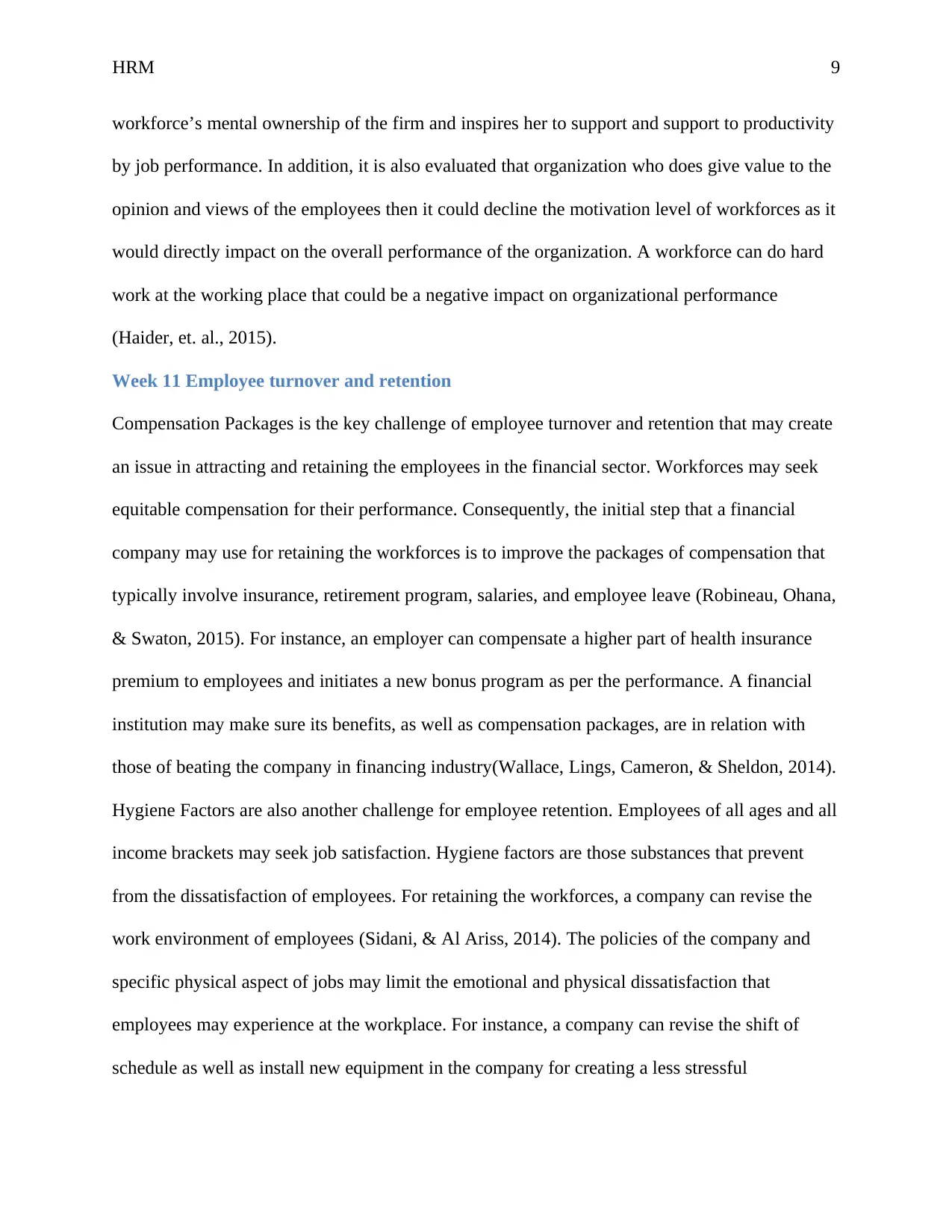
HRM 9
workforce’s mental ownership of the firm and inspires her to support and support to productivity
by job performance. In addition, it is also evaluated that organization who does give value to the
opinion and views of the employees then it could decline the motivation level of workforces as it
would directly impact on the overall performance of the organization. A workforce can do hard
work at the working place that could be a negative impact on organizational performance
(Haider, et. al., 2015).
Week 11 Employee turnover and retention
Compensation Packages is the key challenge of employee turnover and retention that may create
an issue in attracting and retaining the employees in the financial sector. Workforces may seek
equitable compensation for their performance. Consequently, the initial step that a financial
company may use for retaining the workforces is to improve the packages of compensation that
typically involve insurance, retirement program, salaries, and employee leave (Robineau, Ohana,
& Swaton, 2015). For instance, an employer can compensate a higher part of health insurance
premium to employees and initiates a new bonus program as per the performance. A financial
institution may make sure its benefits, as well as compensation packages, are in relation with
those of beating the company in financing industry(Wallace, Lings, Cameron, & Sheldon, 2014).
Hygiene Factors are also another challenge for employee retention. Employees of all ages and all
income brackets may seek job satisfaction. Hygiene factors are those substances that prevent
from the dissatisfaction of employees. For retaining the workforces, a company can revise the
work environment of employees (Sidani, & Al Ariss, 2014). The policies of the company and
specific physical aspect of jobs may limit the emotional and physical dissatisfaction that
employees may experience at the workplace. For instance, a company can revise the shift of
schedule as well as install new equipment in the company for creating a less stressful
workforce’s mental ownership of the firm and inspires her to support and support to productivity
by job performance. In addition, it is also evaluated that organization who does give value to the
opinion and views of the employees then it could decline the motivation level of workforces as it
would directly impact on the overall performance of the organization. A workforce can do hard
work at the working place that could be a negative impact on organizational performance
(Haider, et. al., 2015).
Week 11 Employee turnover and retention
Compensation Packages is the key challenge of employee turnover and retention that may create
an issue in attracting and retaining the employees in the financial sector. Workforces may seek
equitable compensation for their performance. Consequently, the initial step that a financial
company may use for retaining the workforces is to improve the packages of compensation that
typically involve insurance, retirement program, salaries, and employee leave (Robineau, Ohana,
& Swaton, 2015). For instance, an employer can compensate a higher part of health insurance
premium to employees and initiates a new bonus program as per the performance. A financial
institution may make sure its benefits, as well as compensation packages, are in relation with
those of beating the company in financing industry(Wallace, Lings, Cameron, & Sheldon, 2014).
Hygiene Factors are also another challenge for employee retention. Employees of all ages and all
income brackets may seek job satisfaction. Hygiene factors are those substances that prevent
from the dissatisfaction of employees. For retaining the workforces, a company can revise the
work environment of employees (Sidani, & Al Ariss, 2014). The policies of the company and
specific physical aspect of jobs may limit the emotional and physical dissatisfaction that
employees may experience at the workplace. For instance, a company can revise the shift of
schedule as well as install new equipment in the company for creating a less stressful
⊘ This is a preview!⊘
Do you want full access?
Subscribe today to unlock all pages.

Trusted by 1+ million students worldwide
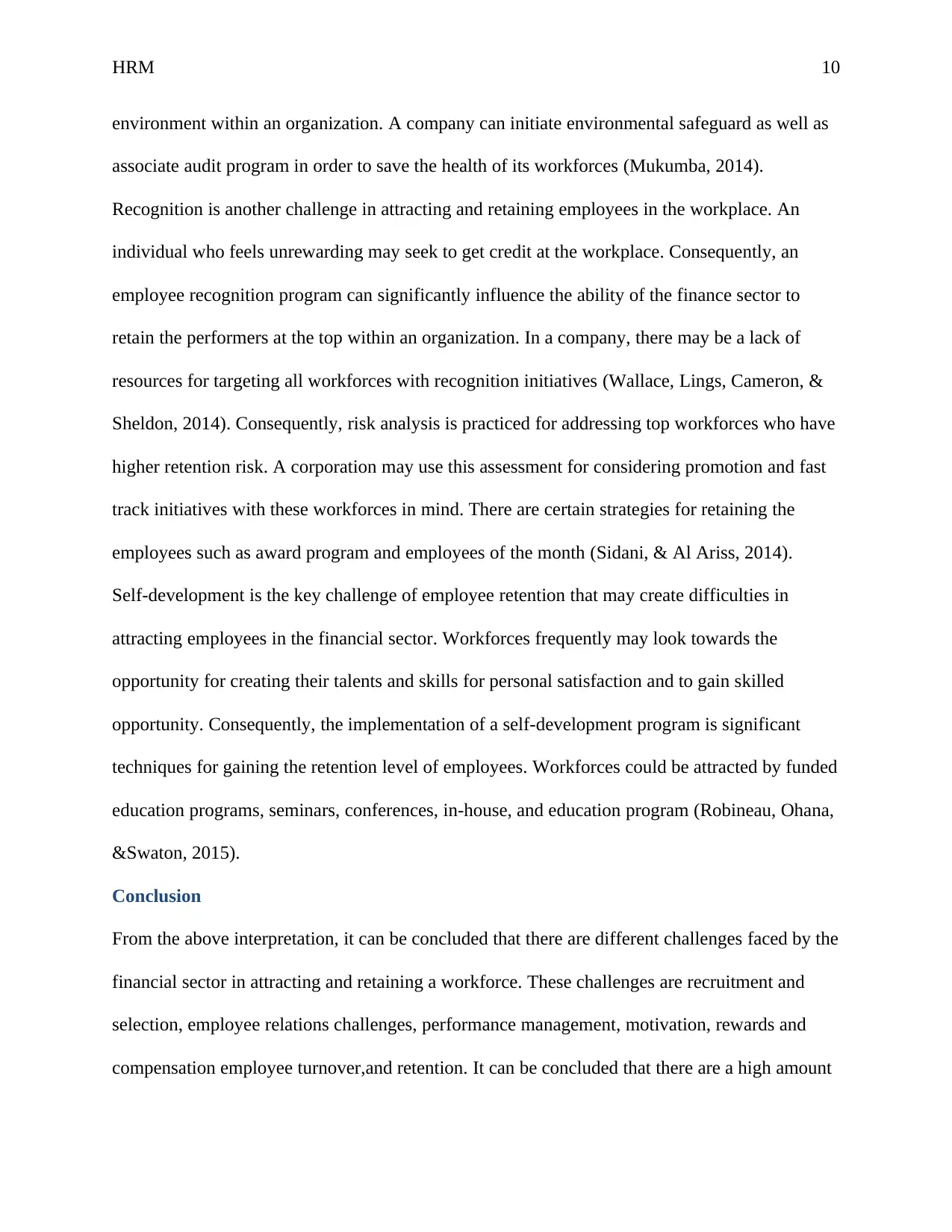
HRM 10
environment within an organization. A company can initiate environmental safeguard as well as
associate audit program in order to save the health of its workforces (Mukumba, 2014).
Recognition is another challenge in attracting and retaining employees in the workplace. An
individual who feels unrewarding may seek to get credit at the workplace. Consequently, an
employee recognition program can significantly influence the ability of the finance sector to
retain the performers at the top within an organization. In a company, there may be a lack of
resources for targeting all workforces with recognition initiatives (Wallace, Lings, Cameron, &
Sheldon, 2014). Consequently, risk analysis is practiced for addressing top workforces who have
higher retention risk. A corporation may use this assessment for considering promotion and fast
track initiatives with these workforces in mind. There are certain strategies for retaining the
employees such as award program and employees of the month (Sidani, & Al Ariss, 2014).
Self-development is the key challenge of employee retention that may create difficulties in
attracting employees in the financial sector. Workforces frequently may look towards the
opportunity for creating their talents and skills for personal satisfaction and to gain skilled
opportunity. Consequently, the implementation of a self-development program is significant
techniques for gaining the retention level of employees. Workforces could be attracted by funded
education programs, seminars, conferences, in-house, and education program (Robineau, Ohana,
&Swaton, 2015).
Conclusion
From the above interpretation, it can be concluded that there are different challenges faced by the
financial sector in attracting and retaining a workforce. These challenges are recruitment and
selection, employee relations challenges, performance management, motivation, rewards and
compensation employee turnover,and retention. It can be concluded that there are a high amount
environment within an organization. A company can initiate environmental safeguard as well as
associate audit program in order to save the health of its workforces (Mukumba, 2014).
Recognition is another challenge in attracting and retaining employees in the workplace. An
individual who feels unrewarding may seek to get credit at the workplace. Consequently, an
employee recognition program can significantly influence the ability of the finance sector to
retain the performers at the top within an organization. In a company, there may be a lack of
resources for targeting all workforces with recognition initiatives (Wallace, Lings, Cameron, &
Sheldon, 2014). Consequently, risk analysis is practiced for addressing top workforces who have
higher retention risk. A corporation may use this assessment for considering promotion and fast
track initiatives with these workforces in mind. There are certain strategies for retaining the
employees such as award program and employees of the month (Sidani, & Al Ariss, 2014).
Self-development is the key challenge of employee retention that may create difficulties in
attracting employees in the financial sector. Workforces frequently may look towards the
opportunity for creating their talents and skills for personal satisfaction and to gain skilled
opportunity. Consequently, the implementation of a self-development program is significant
techniques for gaining the retention level of employees. Workforces could be attracted by funded
education programs, seminars, conferences, in-house, and education program (Robineau, Ohana,
&Swaton, 2015).
Conclusion
From the above interpretation, it can be concluded that there are different challenges faced by the
financial sector in attracting and retaining a workforce. These challenges are recruitment and
selection, employee relations challenges, performance management, motivation, rewards and
compensation employee turnover,and retention. It can be concluded that there are a high amount
Paraphrase This Document
Need a fresh take? Get an instant paraphrase of this document with our AI Paraphraser
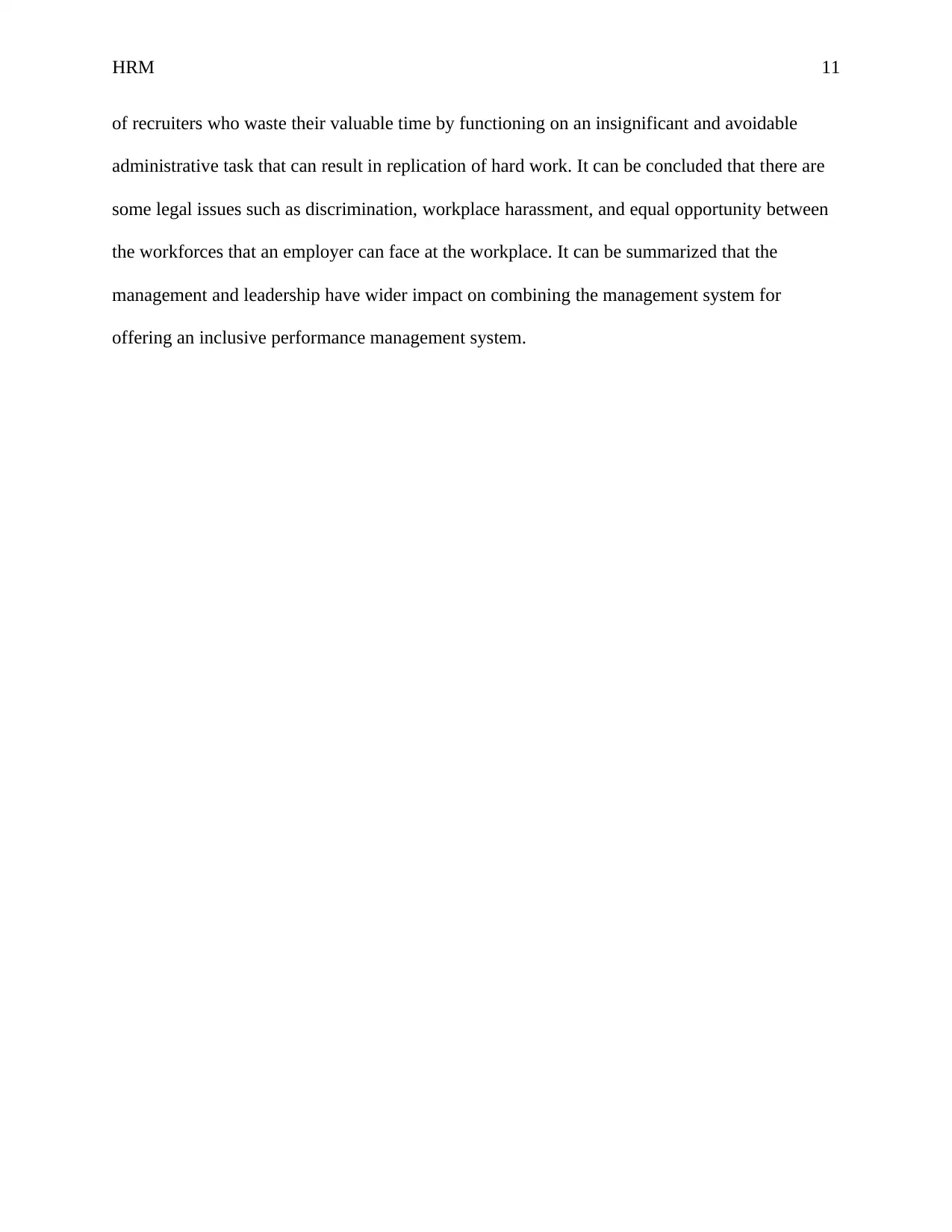
HRM 11
of recruiters who waste their valuable time by functioning on an insignificant and avoidable
administrative task that can result in replication of hard work. It can be concluded that there are
some legal issues such as discrimination, workplace harassment, and equal opportunity between
the workforces that an employer can face at the workplace. It can be summarized that the
management and leadership have wider impact on combining the management system for
offering an inclusive performance management system.
of recruiters who waste their valuable time by functioning on an insignificant and avoidable
administrative task that can result in replication of hard work. It can be concluded that there are
some legal issues such as discrimination, workplace harassment, and equal opportunity between
the workforces that an employer can face at the workplace. It can be summarized that the
management and leadership have wider impact on combining the management system for
offering an inclusive performance management system.
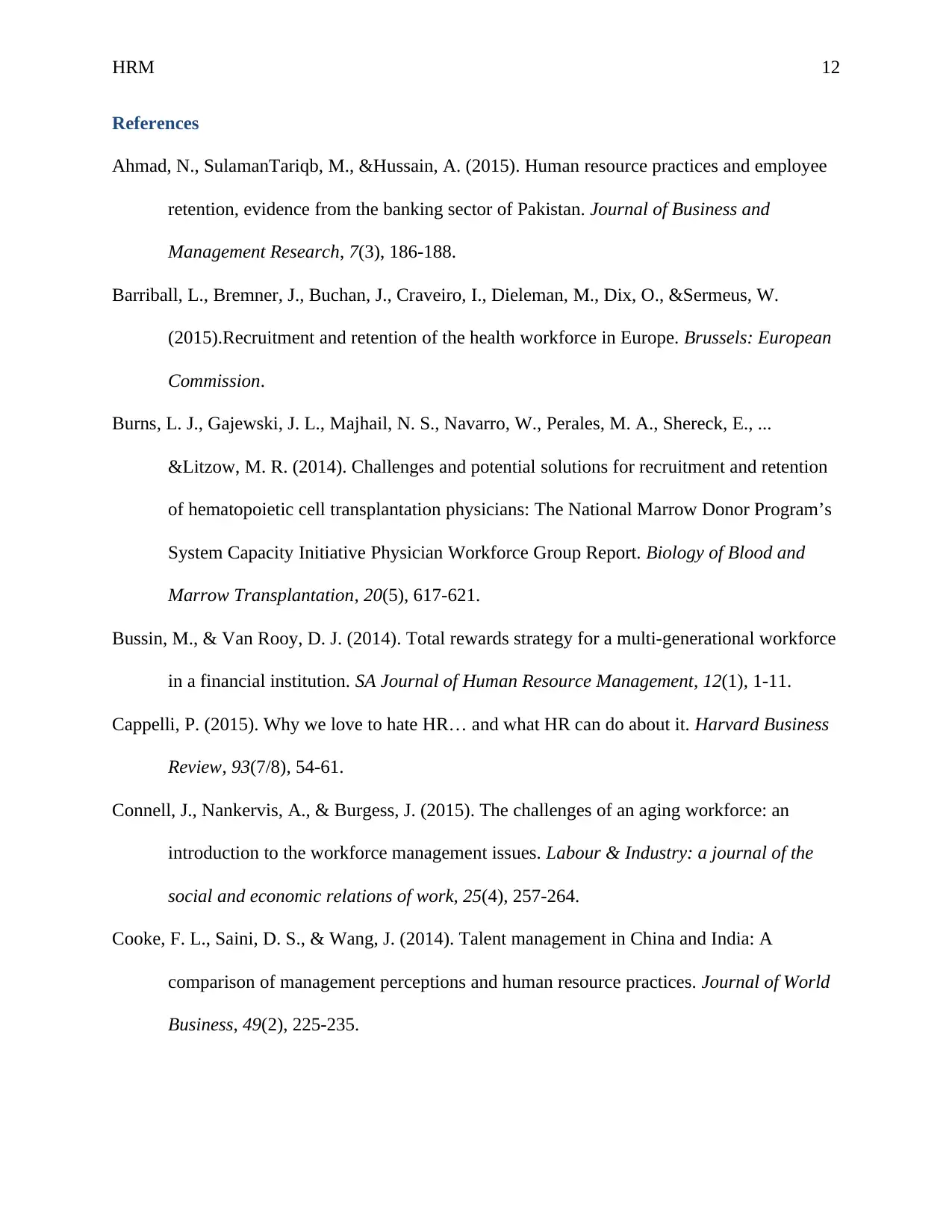
HRM 12
References
Ahmad, N., SulamanTariqb, M., &Hussain, A. (2015). Human resource practices and employee
retention, evidence from the banking sector of Pakistan. Journal of Business and
Management Research, 7(3), 186-188.
Barriball, L., Bremner, J., Buchan, J., Craveiro, I., Dieleman, M., Dix, O., &Sermeus, W.
(2015).Recruitment and retention of the health workforce in Europe. Brussels: European
Commission.
Burns, L. J., Gajewski, J. L., Majhail, N. S., Navarro, W., Perales, M. A., Shereck, E., ...
&Litzow, M. R. (2014). Challenges and potential solutions for recruitment and retention
of hematopoietic cell transplantation physicians: The National Marrow Donor Program’s
System Capacity Initiative Physician Workforce Group Report. Biology of Blood and
Marrow Transplantation, 20(5), 617-621.
Bussin, M., & Van Rooy, D. J. (2014). Total rewards strategy for a multi-generational workforce
in a financial institution. SA Journal of Human Resource Management, 12(1), 1-11.
Cappelli, P. (2015). Why we love to hate HR… and what HR can do about it. Harvard Business
Review, 93(7/8), 54-61.
Connell, J., Nankervis, A., & Burgess, J. (2015). The challenges of an aging workforce: an
introduction to the workforce management issues. Labour & Industry: a journal of the
social and economic relations of work, 25(4), 257-264.
Cooke, F. L., Saini, D. S., & Wang, J. (2014). Talent management in China and India: A
comparison of management perceptions and human resource practices. Journal of World
Business, 49(2), 225-235.
References
Ahmad, N., SulamanTariqb, M., &Hussain, A. (2015). Human resource practices and employee
retention, evidence from the banking sector of Pakistan. Journal of Business and
Management Research, 7(3), 186-188.
Barriball, L., Bremner, J., Buchan, J., Craveiro, I., Dieleman, M., Dix, O., &Sermeus, W.
(2015).Recruitment and retention of the health workforce in Europe. Brussels: European
Commission.
Burns, L. J., Gajewski, J. L., Majhail, N. S., Navarro, W., Perales, M. A., Shereck, E., ...
&Litzow, M. R. (2014). Challenges and potential solutions for recruitment and retention
of hematopoietic cell transplantation physicians: The National Marrow Donor Program’s
System Capacity Initiative Physician Workforce Group Report. Biology of Blood and
Marrow Transplantation, 20(5), 617-621.
Bussin, M., & Van Rooy, D. J. (2014). Total rewards strategy for a multi-generational workforce
in a financial institution. SA Journal of Human Resource Management, 12(1), 1-11.
Cappelli, P. (2015). Why we love to hate HR… and what HR can do about it. Harvard Business
Review, 93(7/8), 54-61.
Connell, J., Nankervis, A., & Burgess, J. (2015). The challenges of an aging workforce: an
introduction to the workforce management issues. Labour & Industry: a journal of the
social and economic relations of work, 25(4), 257-264.
Cooke, F. L., Saini, D. S., & Wang, J. (2014). Talent management in China and India: A
comparison of management perceptions and human resource practices. Journal of World
Business, 49(2), 225-235.
⊘ This is a preview!⊘
Do you want full access?
Subscribe today to unlock all pages.

Trusted by 1+ million students worldwide
1 out of 14
Related Documents
Your All-in-One AI-Powered Toolkit for Academic Success.
+13062052269
info@desklib.com
Available 24*7 on WhatsApp / Email
![[object Object]](/_next/static/media/star-bottom.7253800d.svg)
Unlock your academic potential
Copyright © 2020–2025 A2Z Services. All Rights Reserved. Developed and managed by ZUCOL.

